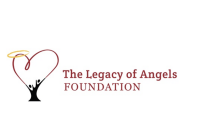Our News & Events
Rosenau Family Research Foundation funds UB research focused on new therapeutic target for Krabbe disease

January 10, 2025
A UB researcher working on Krabbe disease (KD) has been awarded a $250,000 grant from the Rosenau Family Research Foundation to investigate how an enzyme deficiency in the brain causes this disease, which is usually fatal by age 2.
The two-year grant will fund the work of Daesung Shin, assistant professor in the Department of Biotechnical and Clinical Laboratory Sciences in the Jacobs School of Medicine and Biomedical Sciences at UB.
KD is an inherited disorder that destroys the myelin sheath, the protective coating of nerve cells in the brain and throughout the nervous system. Symptoms, including paralysis and blindness, typically develop in babies before 6 months of age; it’s usually fatal by age 2. KD can occur in older children and adults, when the course of the disease can vary greatly.
It is known that KD is caused by a deficiency of galactosylceramidase (GALC), an enzyme that breaks down galactosylceramide, an important component of myelin, which ensures the rapid transmission of nerve impulses.
However, Shin says, there has been a lack of understanding of how the GALC deficiency leads to the symptoms of KD. He and his UB colleagues have found that a type of overactive signaling in the brain may be responsible for causing the disease.
“We have evidence that the signaling of hyperactive nuclear factor-kappa B(NF-kB), a family of proteins that acts like a switch to control which genes are turned on for inflammation, in the Krabbe brain is contributing to the phenotype we observe,” Shin explains. “This grant from the Rosenau Family Research Foundation will help us to determine if targeting the NF-kB pathway could offer a promising therapeutic avenue for Krabbe disease.”
...
Feltri’s Legacy on Full Display At Neuroscience Research Day
October 3, 2024
The 17th annual Neuroscience Research Day at the Jacobs School of Medicine and Biomedical Sciences on Sept. 26 was filled with an aura of warmth and positivity. The uplifting atmosphere stemmed from the decision to dedicate the 2024 event to the memory of the late M. Laura Feltri, MD, a cherished member of the Jacobs School community who passed away from cancer at the age of 60 in December 2023.
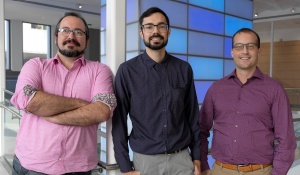
Made Numerous Seminal Discoveries in Her Field
An internationally renowned pioneer in the study and treatment of myelin diseases in the nervous system, Feltri was a SUNY Distinguished Professor of biochemistry and neurology in the Jacobs School and director of UB’s Institute for Myelin and Glia Exploration.
Her research focused on multiple sclerosis; Charcot-Marie-Tooth disease, which affects the peripheral nerves; and Krabbe leukodystrophy, a rare, fatal neurological disease that afflicts newborns.
With major funding from the National Institutes of Health (NIH), Feltri made numerous seminal discoveries in her field, including the creation of the first mutagenesis tool for studying Schwann cell development and the signaling mechanisms that control myelination.
In collaboration with her husband, Lawrence Wrabetz, MD, she pioneered the use of transgenic animals to model neurological diseases and develop new therapies. Feltri was a faculty member and head of the NeuroGlia Unit at the San Raffaele Scientific Institute in Milan, Italy, before joining the UB faculty in 2011.
Mentor and Friend to Many at University
Several of Feltri’s colleagues and mentees spoke at the research event, and as they reflected on Feltri and her legacy, it became evident that in addition to being a brilliant scientist, she was also a truly caring and supportive friend to many.
During welcoming remarks, Allison Brashear, MD, MBA, UB’s vice president for health sciences and dean of the Jacobs School, said Feltri “was a visionary leader whose many, many contributions are deeply appreciated here at the Jacobs School and across the world and is deeply missed.”
“Dr. Feltri really energized the next generation. She would be heartened to see all the future scientists here in the room,” she said.
Fraser J. Sim, PhD, director of the Jacobs School’s neuroscience program, organized the research day event along with David Dietz, PhD, professor and chair of pharmacology and toxicology; Maureen Milligan, Liz Marshall Metcalfe, Marah Salyer and Shannon Brown.
Sim said Feltri was much more than a brilliant researcher.
“When I was a junior faculty member joining UB as the only neurobiologist, I remember meeting Laura and Larry,” he said. “And Laura, with her very grounded nature, and despite being this world renowned-expert, was very kind. She helped me and so many others find their footing here at UB.”
Sim said Feltri’s ability to mentor was especially unique.
“She had a way of offering constructive feedback that wasn’t just helpful, it was transformative to the way you thought about the science that you were doing,” he said. “But she also never minced words. Her critiques were always delivered with care and thoughtfulness and that is something I have always tried to emulate as a principal investigator myself.”
...
17th Annual Buffalo Neuroscience Research Day
September 26, 2024
This year’s Buffalo Neuroscience Research Day is dedicated to the memory of the preeminent M. Laura Feltri, MD, who passed away in December 2023. The event will feature a host of presentations by Dr. Feltri’s colleagues and trainees, along with UB faculty and student presenters.
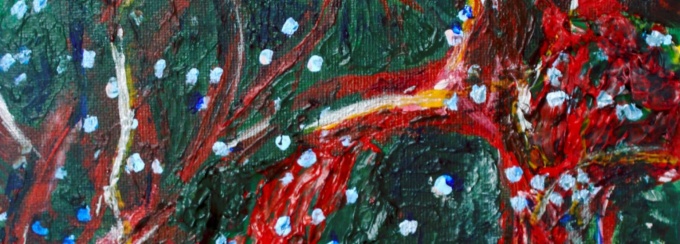
Celebrating Her Legacy
A widely respected scholar and a member of the Jacobs School of Medicine and Biomedical Sciences faculty, she was a SUNY Distinguished Professor of biochemistry and neurology in the Jacobs School and director of UB’s Institute for Myelin and Glia Exploration.
Her research focused on multiple sclerosis; Charcot-Marie-Tooth disease, which affects the peripheral nerves; and Krabbe leukodystrophy, a rare, fatal neurological disease that afflicts newborns.”
Feltri was an internationally renowned pioneer in the study and treatment of myelin diseases in the nervous system. She made numerous seminal discoveries in her field, including developing the first mutagenesis tool for studying the development of Schwann cells, which generate myelin, and the signals that regulate myelination.
In Memoriam: Laura Feltri: Of Schwann cells, matrix, and family

March 14, 2024
Laura Feltri (1963–2023) has been a pioneer in the study of ex- tracellular matrix (ECM) in peripheral nervous system (PNS) myelination. Her journey in science began at the University of Milan, where she obtained an MD and did a residency in neu- rology. Despite being trained as a physician, Laura’s curiosity for understanding the complexity of peripheral nerves drew her toward research. Like several other talented students, she was offered, during her residency, a training fellowship at the Uni- versity of Pennsylvania. She thus joined the lab of Michael Shy and became fascinated by science and research. The environ- ment at UPenn was vibrant and full of junior physician scien- tists, combining the passion for science with the desire to better understand the pathological mechanisms that underlie diseases of the PNS. This extraordinary team, composed also of John Kamholz, Steve S. Scherer, and Larry Wrabetz, was instru- mental in Laura’s education as a scientist, future career, and life.
In the early ’90s, Laura came back to Milan with Larry to initiate a new chapter in their life. She and Larry eventually married on a beautiful day in September on Lake Como. Until last Christmas, when Laura passed away due to a glioma that she strenuously fought, they had been a unique couple capable of balancing life and career in good and bad, in health and sickness, as they vowed each other on their wedding day.
In addition to creating a new family, they established their first laboratory at the San Raffaele Scientific Institute in Milan. This was a great opportunity for both, as the institute had just been built and was recruiting the best scientists willing to pursue their career in Italy in a multidisciplinary environment.
We were among the first to join the “L&L” lab in Milan, and we remember those years being full of enthusiasm, passion, and fun. We both recall the Monday mornings dedicated to speaking Italian—Larry was taking Italian lessons in the afternoon, and this was “homework time.” However, most of the time, he was making fun of Laura as she could not explain in a crystal-clear way the intricacies of the Italian language.
Those were also difficult days, though, as the funding in Italy was neither substantial nor consistent, and Laura was forced to spend much of her time figuring out how to manage the lab. However, throughout those years, Laura and Larry were able to...
IMAGE students Corral & Dhimal featured in Mural that celebrates Jacobs School diversity
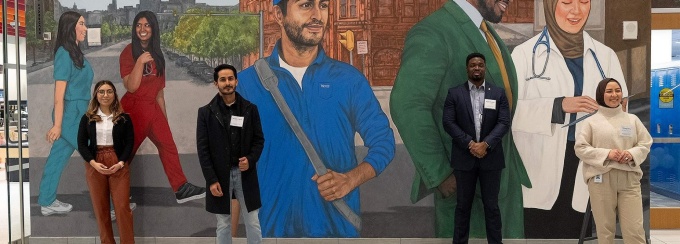
February 28, 2024
A ribbon-cutting ceremony last Thursday marked completion of the massive, larger-than-life-sized “Celebration of Diversity” mural in the atrium of the Jacobs School of Medicine and Biomedical Sciences.
Stretching from floor to ceiling along the north wall of the school’s second-floor atrium, the mural created by Buffalo-based visual artist Julia Bottoms measures 50 feet wide by 16 feet tall.
“The completion of this beautiful mural, featuring actual members of our Jacobs School community, holds deep significance for us,” says Allison Brashear, vice president for health sciences and dean of the Jacobs School. “It embodies our diversity and our commitment to Buffalo, reflecting our shared dedication to an inclusive environment where all can flourish.”
The mural has been in the works since 2019. Discussions about how the medical school needed more color started after the new building opened between Raul Vazquez, a 1989 Jacobs School graduate; his wife, Toni Gaiter-Vazquez, a 1991 UB graduate; and the late Jonathan D. Daniels, a 1998 Jacobs School graduate and former associate director of admissions.
In Memoriam: M. Laura Feltri, MD

January 3, 2024
M. Laura Feltri, MD, an internationally renowned pioneer in the study and treatment of myelin diseases in the nervous system, died Dec. 25 in her native Italy after a long and courageous battle with cancer. She was 60.
A SUNY Distinguished Professor
A widely respected scholar and a member of the Jacobs School of Medicine and Biomedical Sciences faculty, she was a SUNY Distinguished Professor of biochemistry and neurology in the Jacobs School and director of UB’s Institute for Myelin and Glia Exploration.
She was elected a fellow of the American Association for the Advancement of Science (AAAS) earlier this year for her lifetime achievements.
“Dr. Feltri was an internationally recognized neuroscientist, a mentor to many and a friend to all,” said Allison Brashear, MD, MBA, vice president for health sciences at UB and dean of the Jacobs School. “The school will be working with her many friends to honor her legacy in the coming year.”
Numerous Seminal Discoveries in Her Field
Her research focused on multiple sclerosis (MS); Charcot-Marie-Tooth (CMT) disease, which affects the peripheral nerves; and Krabbe leukodystrophy, a rare, fatal neurological disease that afflicts newborns.
With major funding from the National Institutes of Health, Feltri made numerous seminal discoveries in her field, including developing the first mutagenesis tool for studying the development of Schwann cells, which generate myelin, and the signals that regulate myelination. In collaboration with her husband, Lawrence Wrabetz, MD, she pioneered the use of transgenic animals to model neurological diseases and develop new therapies.
In her career, Feltri authored over 140 peer-reviewed research articles.
Numerous national and international organizations sought Feltri’s expertise. She served on the review panel of the Muscular Dystrophy Association and the National Multiple Sclerosis Society. She was first a member and then chair of the Cellular & Molecular Biology of Glia Study section of the National Institute of Neurological Disorders and Stroke of the NIH. She also served as scientific advisor to the Charcot Marie Tooth Association, the CMT4B3 Research Foundation and KrabbeConnect.
“Laura was a joy to work with. Despite receiving many accolades, she was self-critical and sought constantly to improve her scholarship, teaching and mentoring,” said Mark R. O’Brian, PhD, professor and chair of the Jacobs School’s Department of Biochemistry. “She made us all better.”
Early in her career, Feltri was awarded the International Society for Neurochemistry’s Young Investigators’ Colloquia Award. In 2020, she was an invited speaker at the Nobel Mini-Symposium at the Karolinska Institute in Stockholm.
Feltri was an excellent adviser and mentor to numerous undergraduate, master’s and doctoral students and in 2013 UB’s Office of Postdoctoral Scholars awarded her a Distinguished Postdoc Mentor Award.
She was president-elect of the Peripheral Nerve Society and served on the editorial board of various journals and the boards of several scientific organizations.
Feltri earned her medical degree and did her residency in neurology at the University of Milano. She was a postdoctoral fellow at Thomas Jefferson University. She was a faculty member and head of the NeuroGlia Unit at the San Raffaele Scientific Institute in Milano, Italy before joining the UB faculty in 2011.
Survivors include her husband and five children.
Feltri named AAAS Fellow

February 2, 2023
University at Buffalo faculty members Stelios Andreadis, PhD, and M. Laura Feltri, MD, have been elected fellows of the American Association for the Advancement of Science (AAAS), the world’s largest general scientific society and publisher of the Science family of journals.
The lifetime honor is bestowed on AAAS members by their peers for their scientifically or socially distinguished efforts to advance science applications. The UB faculty members were among more than 500 scientists, engineers and innovators to receive the prestigious distinction this year. Past honorees include W.E.B. DuBois, Ellen Ochoa, Steven Chu, Grace Hopper, Alan Alda, Mae Jemison and Ayanna Howard.
AAAS fellows will be recognized in the journal Science this month and they will be celebrated in an induction ceremony to be held this summer.
...
M. Laura Feltri, SUNY Distinguished Professor of biochemistry and neurology in the Jacobs School of Medicine and Biomedical Sciences, and director of UB’s Institute for Myelin and Glia Exploration, is an internationally renowned expert and pioneer in the study of myelin diseases in the nervous system and the development of novel treatments for them.
With major funding from the National Institutes of Health, Feltri has made numerous seminal discoveries in her field, including developing the first mutagenesis tool for studying the development of Schwann cells, which generate myelin, and the signals that regulate myelination. In collaboration with Lawrence Wrabetz, she pioneered the use of transgenic animals to model neurological diseases and develop new therapies.
Feltri’s research focuses on multiple sclerosis (MS); Charcot-Marie-Tooth (CMT) disease, which affects the peripheral nerves; and Krabbe leukodystrophy, a rare, fatal neurological disease that afflicts newborns.
Her most recent research allowed for identification of a molecular target that inhibits remyelination in MS, as well as several targets that may improve CMT hereditary neuropathies. She and her colleagues are partnering with the Empire Discovery Institute and with pharmaceutical companies on these efforts.
Feltri also studies how Krabbe disease occurs by developing organoids — lab-grown “mini-brains” — produced from the stem cells of people with and without the disease. This work is funded by Legacy of Angels, a foundation that supports research into developing and enhancing treatments for Krabbe disease and for cystic fibrosis.
Numerous national and international organizations have sought Feltri’s expertise. She has served on the review panel of the Muscular Dystrophy Association and the National Muliple Sclerosis Society. She was first a member and then chair of the Cellular & Molecular Biology of Glia Study section of the National Institute of Neurological Disorders and Stroke of the NIH. She also serves as scientific adviser to the Charcot Marie Tooth Association, the CMT4B3 Research Foundation and KrabbeConnect.
Early in her career, she was awarded the International Society for Neurochemistry’s Young Investigators’ Colloquia Award. In 2020, she was an invited speaker at the Nobel Mini-Symposium at the Karolinska Institute in Stockholm.
Feltri has advised and mentored numerous undergraduate, master’s and doctoral students at UB and in 2013 UB’s Office of Postdoctoral Scholars awarded her a Distinguished Postdoc Mentor Award.
Feltri is president-elect of the Peripheral Nerve Society and serves on the editorial board of various journals and the boards of several scientific organizations. In 2026, she will chair the Myelin Gordon conference.
Feltri Lab student wins best poster award at Society for Neuroscience, Buffalo chapter

Sri Laxmi Veerapaneni
November 10, 2022
This year University at Buffalo, Society of Neuroscience chapter conducted an annual research day. Along with oral presentations, many students participated in poster presentations. Out of 47 poster presentations, Sri Laxmi Veerapaneni is one of the four students who received the award. For abstracts and details, visit: https://sfn.med.buffalo.edu
Sri Laxmi Veerapaneni, a graduate student works in the lab of M. Laura Feltri, MD, SUNY Distinguished Professor of biochemistry and neurology and director of the Institute for Myelin and Glia Exploration.
She is studying the role of Transcription factor EB (TFEB) in peripheral myelination. Transcription factor EB (TFEB) is a master transcriptional factor of autophagy and lysosomal proteins. Aside from its role in lysosomal debris clearance and autophagy, recent studies have shown that hyperactive TFEB in oligodendrocytes can repress myelination, and its absence can cause ectopic myelination during development in the central nervous system (CNS). She hypothesizes that TFEB has a similar role in the peripheral nervous system (PNS) which might help in further understanding of demyelinating diseases.
Two Doctoral Students Win SUNY GREAT Awards
March 11, 2022
The two Jacobs School students to receive a 2022 SUNY GREAT Award are Steven A. Lewis, a trainee in the doctoral program in computational cell biology, anatomy and pathology; and Narayan Dhimal, a trainee in the doctoral program in neuroscience.
They are among 28 SUNY students receiving the GREAT awards; all award winners have also been recognized nationally for their research by prestigious graduate fellowship programs sponsored by the National Science Foundation (NSF) or the National Institutes of Health (NIH).
Dhimal works in the lab of M. Laura Feltri, MD, SUNY Distinguished Professor of biochemistry and neurology and director of the Institute for Myelin and Glia Exploration.
He is studying the roles of autophagy and TFEB transcription factor in Krabbe disease (KD), a demyelinating disorder of the central and the peripheral nervous system caused by lack of GALC (galactosylceramidase)
enzyme function.
From his work, Dhimal says he hopes to find a therapeutic strategy where pharmacologically increasing or modulating the autophagy process might be beneficial and may serve as a combination treatment, along with bone marrow therapy, as well as ongoing gene therapy trials.
We Celebrate International Women's Day 2022
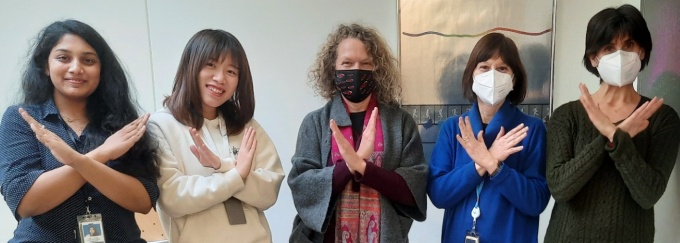
Sri Laxmi Veerapaneni, Xiaoyu Zhu, Maureen Milligan, M. Laura Feltri, Veronica Cheli
March 8, 2022
A few of the women at the Institute for Myelin and Glia Exploration got together to celebrate #IWD2022 by striking a pose in support the goals of this day and posting on social media:
- A world free of bias, stereotypes, and discrimination.
- A world that is diverse, equitable, and inclusive.
- A world where difference is valued and celebrated.
- Together we can forge women's equality.
- Collectively we can all #BreakTheBias.
The 5 women in this photo hail from 4 continents: Asia; Europe; South America and North America.
For more information see: https://www.internationalwomensday.com
Chancellor's Distinguished Dissertation Award

Gustavo Della Flora Nunes, Postdoctoral Researcher
November 1, 2021
Chancellor Malatras Announces the Winners of the Inaugural Chancellor Distinguished PhD Graduate Disseration Awards.
Honorable mention includes:
- Gustavo Della Flora Nunes, University at Buffalo, Department of Biochemistry
- Dissertation: "Elucidating the role of Schwann cell mitochondria in myelin maintenance"
Albany, NY – State University of New York Chancellor Jim Malatras today announced winners of the inaugural Chancellor Distinguished PhD Graduate Dissertation Awards. Frist place was awarded to Binghamton University, Department of History student Dr. Jonathan S. Jones for his dissertation, “Opium Slavery: Veterans and Addiction in the American Civil War Era.” Jones and four finalists were selected amongst nominations of SUNY PhD student dissertations. Jones received the top prize of $5,000 to be used for professional development, and finalists were awarded $1,000 for professional development opportunities as well. The three honorable mentions were awarded $250. Each awardee’s work will be published by SUNY Press—a rare opportunity in public higher education—in Spring 2022.

Laura Feltri, MD, HJKRI
Two UB researchers receive investments from Empire Discovery Institute
May 7, 2021
Two UB drug development and discovery projects have received investments from the Empire Discovery Institute.
One project focuses on an immunotherapy platform — developed by UB pharmacy researcher Sathy Balu-Iyer and his team — that could benefit patients who are receiving gene therapy for a variety of diseases. The other will seek to design a therapy for multiple sclerosis (MS) that leverages a novel drug target discovered by a team led by UB medical researcher M. Laura Feltri.
The institute will advance both efforts through its Medicines Discovery Award Program, a competitive incubator and accelerator program designed to identify and advance promising early-stage drug discovery into early “proofs of concept.” Successful projects will exit the program as either a licensing transaction to a strategic pharmaceutical partner or as an Empire Discovery Institute-created startup company.
Empire Discovery Institute is a nonprofit New York drug discovery and development accelerator created to translate important academic discoveries into new medicines for commercialization by providing strategic support and pharmaceutical development expertise. Established with $35.4 million in initial funding from Empire State Development, it works in partnership with research labs at UB, the University of Rochester and Roswell Park Comprehensive Cancer Center.
43 New Faculty Members Join 12 Departments
February 3, 2021
Forty-three faculty members with a variety of clinical and research experience — representing 12 medical school departments — have joined the Jacobs School of Medicine and Biomedical Sciences over the past several months.
Daesung Shin, PhD, is an assistant professor of biotechnical and clinical laboratory sciences. He has expertise in areas including gene expression, gene therapy, inherited metabolic disorders, molecular and cellular biology, molecular genetics, neurobiology, signal transduction, and transgenic organisms.
Shin earned his doctoral degree from the Korea Advanced Institute of Science and Technology. He comes to the Jacobs School from the Hunter James Kelly Research Institute.
Students Share Findings During GGB Research Day

Narayan Dhimal, PhD Student, Feltri Lab, HJKRI
January 29, 2021
Students and laboratories affiliated with the Genetics, Genomics and Bioinformatics graduate program (GGB) shared their findings during the seventh annual GGB Research Day.
There were 14 participants, with four delivering oral presentations and 10 presenting a research poster. Cash prizes of $100 each were awarded to the best in category in oral presentation and poster presentation.
The “Best Poster Presentation Award” was presented to Narayan Dhimal, a doctoral student in the neuroscience program, for his study titled “Autophagy is Defective in Schwann Cells in Krabbe Disease.”
His mentor is M. Laura Feltri, MD, professor of biochemistry and neurology and co-director of the Hunter James Kelly Research Institute (HJKRI).
New Findings: Breakthrough in Nerve Biology

L to R: Keit Men Wong, Bogdan Beirowski and Elisabetta Babetto
October 2, 2020
New research reveals for the first time that despite the fragility of axons, Schwann cells — which surround axons within nerves like a glove covers a hand — can come to the assistance of injured axons.
Axons are long, finger-like projections of neurons that transmit critical signals throughout the nervous system. But because they are energetically difficult to maintain, they are often among the first casualties of certain neurodegenerative diseases, causing symptoms such as muscle weakness or numbness of limbs.
The paper, “A Glycolytic Shift in Schwann Cells Supports Injured Axons,” was published in Nature Neuroscience.
Newly discovered ‘support system’ for axons suggests a novel therapeutic target for neurodegenerative diseases
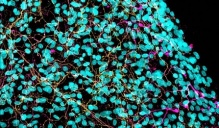
This image shows axons in vitro 24 hours after injury. The presence of Schwann cells (nuclei in cyan) helped maintain the integrity of axons (in magenta and yellow). Image credit: Elisabetta Babetto, HJKRI
August 25, 2020
Axons are long, finger-like projections of neurons that transmit critical signals throughout the nervous system. But because they are fragile, they are often among the first casualties of certain neurodegenerative diseases, causing symptoms such as muscle weakness or numbness of limbs.
New research from the University at Buffalo reveals that despite the fragility of axons, the cellular envelope (Schwann cells) that encases them can come to their rescue when it senses that axons have been harmed.
Published in Nature Neuroscience last week, the paper reveals for the first time that Schwann cells, which surround axons within nerves like a glove covers a hand, can come to the assistance of injured axons.
Research Clarifies Cellular Mechanisms in Krabbe Fight
NEURON cover image is an artistic impression of a nerve from a globoid cell leukodystrophy patient that did not receive HSCT. Artwork by Camilla Wrabetz.

Nadav Isaac Weinstock is first author on a paper whose findings could lead to improved outcomes for Krabbe disease patients.
July 8, 2020
Jacobs School of Medicine and Biomedical Sciences researchers have published a paper that clarifies certain cellular mechanisms that could lead to improved outcomes in patients with globoid cell leukodystrophy, commonly known as Krabbe disease.
The paper, titled “Macrophages Expressing GALC Improve Peripheral Krabbe Disease by a Mechanism Independent of Cross-Correction,” was featured as the cover story published July 8 in the journal Neuron, with a “preview” synopsis written by Vittorio Gallo, PhD, chief research officer of the Children’s National Hospital and scientific director of the Children’s National Research Institute.
The research was led by M. Laura Feltri, MD, and Lawrence Wrabetz, MD, co-directors of the Hunter James Kelly Research institute (HJKRI) and professors of biochemistry and neurology in the Jacobs School; and by Daesung Shin, PhD, research assistant professor of biochemistry.
UB investigators uncover cellular mechanism involved in Krabbe disease

First author, Nadav I. Weinstock, MD-PhD candidate, University at Buffalo
May 5, 2020
BUFFALO, N.Y. – A group of researchers at the University at Buffalo have published a paper that clarifies certain cellular mechanisms that could lead to improved outcomes in patients with globoid cell leukodystrophy, commonly known as Krabbe disease.
The paper, titled “Macrophages Expressing GALC Improve Peripheral Krabbe Disease by a Mechanism Independent of Cross-Correction,” was published today (May 5) in the journal Neuron.
The research was led by Lawrence Wrabetz, MD, and M. Laura Feltri, MD. Wrabetz and Feltri head the Hunter Jameas Kelly Research Institute (HJKRI) and both are professors in the departments of Biochemistry and Neurology in the Jacobs School of Medicine and Biomedical Sciences at UB.
Study: Axon Degeneration Due to Sick Oligodendrocytes

Elisabetta Babetto, PhD, and Bogdan K. Beirowski, MD, PhD, are leading a study seeking to find novel therapeutic approaches to specifically protect axons from degeneration.
April 16, 2020
Jacobs School of Medicine and Biomedical Sciences researchers are seeking to improve understanding of the glial maintenance and support of axons — the very long cellular projections of neurons relaying electrical and biochemical signals in nerves and white-matter tracts of the nervous system.
Bogdan K. Beirowski, MD, PhD, assistant professor of biochemistry, and Elisabetta Babetto, PhD, senior research scientist in biochemistry and research assistant professor of pharmacology and toxicology, are leading the study.
As investigators at the Hunter James Kelly Research Institute (HJKRI), they have been awarded a five-year, $1.9 million grant from the National Institute of Neurological Disorders and Stroke for their study titled “Elucidating the Trophic Support of Long Axons by Metabolic Signaling in Oligodendrocytes.”
Five named SUNY Distinguished Professors
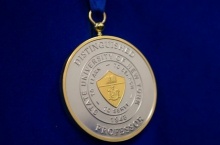
SUNY Distinguished Professors award.

M. Laura Feltri, SUNY Distinguished Professor of Biochemistry & Neurology
April 9, 2020
Five UB faculty members have been named SUNY Distinguished Professors, the highest faculty rank in the SUNY system.
M. Laura Feltri, Jo Freudenheim, Amit Goyal, Elad Levy and Stephen Tiffany were appointed to the distinguished professor ranks by the SUNY Board of Trustees at its meeting on March 17.
Graduate Student, Narayan Dhimal, Joins the Feltri Laboratory
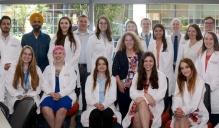
Narayan Dhimal pictured with Doctoral students, MD-PhD students and mentors at the PhD Program in Biomedical Sciences’ third annual white coat ceremony.
PPBS White Coat Ceremony Honors Student Advancement
July 1, 2019
The PhD Program in Biomedical Sciences (PPBS) conducted its third annual white coat ceremony to recognize 19 students from the Class of 2018-2019 — 14 doctoral students and five MD-PhD students — who completed their first year in the program and are moving on to their research laboratory match.
...
14 PPBS Students Match into Research Lab
The PPBS students were cloaked by the faculty members into whose research labs they matched.
Pursuing New Direction to Understand Krabbe Disease

M. Laura Feltri, MD, and Lawrence Wrabetz, MD
May 7, 2019
The Hunter James Kelly Research Institute (HJKRI) has received more than $2 million in National Institutes of Health (NIH) funding, enabling researchers to pursue a new approach to Krabbe disease.
Research Will Pinpoint Cells Needing Correction
Co-principal investigators on the grant — co-directors of the HJKRI M. Laura Feltri, MD, professor of biochemistry and neurology, and Lawrence Wrabetz, MD, professor of neurology and biochemistry — say the new approach focuses on the peripheral nervous system as a possible “window” into the disease.
“What’s exciting about this grant is that we are leading research on Krabbe disease in a new direction,” Feltri says. “Our research will pinpoint which cells need correction, using methods such as gene therapy, in order to cure the disease."
Jacobs Faculty Members Earn SUNY Chancellor’s Awards
May 6, 2019
Four Jacobs School of Medicine and Biomedical Sciences faculty members have been selected as recipients of 2019 SUNY Chancellor’s Awards for Excellence.
The Chancellor’s Awards acknowledge and provide systemwide recognition for consistently superior professional achievement, and they encourage the ongoing pursuit of excellence.
Groundbreaking Research on Myelin Disorders
M. Laura Feltri, MD, professor of biochemistry and neurology, was awarded the Chancellor’s Award for Excellence in Scholarship and Creative Activities, which recognizes the work of those who engage actively in scholarly and creative pursuits beyond their teaching responsibilities.
UB Scientists Studying Krabbe’s Disease Take a Novel Approach
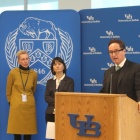
Norma Nowak, NYS Center of Excellence in Bioinformatics and Life Sciences, Executive Director; HJKRI Co-director M. Laura Feltri and Rep. Brian Higgins
March 28, 2019
The funding allows UB researchers at the institute to pursue a new approach to Krabbe’s Disease, also called globoid cell leukodystrophy, a rare, neurological disease that afflicts newborns and is fatal.
This new direction, Higgins noted, comes about as a result of the continued investment in the institute, one of a handful of research institutes in the world with an exclusive focus on myelin and diseases of myelin, such as multiple sclerosis, demyelinating neuropathies and leukodystrophies, and how they may be treated.
Congressman Higgins Announces Over $2M in Federal Funding to Support Krabbe Disease Research at the Hunter James Kelly Research Institute at UB
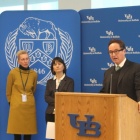
Norma Nowak, NYS Center of Excellence in Bioinformatics and Life Sciences, Executive Director; HJKRI Co-director M. Laura Feltri and Rep. Brian Higgins
March 25, 2019
New Grant Supporting 5-Year Project Is the Latest In A Series of Awards Furthering Krabbe Disease Research in WNY
Congressman Brian Higgins (NY-26) announced millions of dollars in federal funding to support the research of Krabbe leukodystrophy, known as Krabbe Disease (KD). A grant from the National Institutes of Health (NIH) in the amount of $433,627 in the first year and over $2 million over a five-year period has been awarded to M. Laura Feltri, MD and Lawrence Wrabetz, MD, co-directors of the Hunter James Kelly Research Institute (HJKRI) at the University at Buffalo (UB). This is just the latest in a series of awards furthering Krabbe Disease research earned by the Institute this year.
MD-PhD Student Awarded Prestigious NIH Fellowship
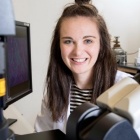
Chelsey Reed, PhD Student, HJKRI, Wrabetz lab
October 25, 2018
Chelsey Reed, a student in the MD-PhD Program, has been awarded a prestigious fellowship from the National Institutes of Health (NIH).
The Ruth L. Kirschstein National Research Service Award Fellowship (F30) is intended to enhance research and clinical training of promising predoctoral students who are matriculated in a combined MD/PhD training program and plan to pursue careers as physician-scientists.
Studying Cellular Stress Response Pathways
Reed is an MD-PhD student in the neuroscience program and is working at the Hunter James Kelly Research Institute (HJKRI) in the laboratory of Lawrence Wrabetz, MD, professor of neurology and biochemistry, and inaugural director of the Institute.
Axonal Degeneration Focus of Multiple Studies at HJKRI

Elisabetta Babetto, PhD, left, and Bogdan K. Beirowski, MD, PhD
August 3, 2018
Researchers, Elisabetta Babetto, PhD and Bogdan K. Beirowski, MD, PhD at the Hunter James Kelly Research Institute (HJKRI) have been awarded a pair of grants for the investigation of mechanisms underlying axonal degeneration in certain neurological disorders.
‘Underlying Mechanisms Poorly Understood’
A grant funded by the Muscular Dystrophy Association (MDA) was awarded to Bogdan K. Beirowski, MD, PhD, assistant professor of biochemistry.
Elisabetta Babetto, PhD, senior research scientist in biochemistry and research assistant professor of pharmacology and toxicology in the Institute, was awarded a grant funded by GBS/CIDP Foundation International.
HJKRI Collaborator: Sim Research Exploring New Drug Therapies for Multiple Sclerosis
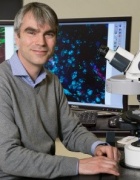
Fraser J. Sim, PhD
March 28, 2018
Research led by Fraser J. Sim, PhD, associate professor of pharmacology and toxicology, that seeks to spur development of cellular and molecular therapies for adult demyelinating disease, such as multiple sclerosis, has gained funding from the National Institutes of Health.
Investigating Strategies to Improve Myelin Repair
In multiple sclerosis, impaired oligodendrocyte differentiation limits remyelination and leads to axonal atrophy and neurodegeneration, according to Sim, principal investigator on the grant.
“Drugs which block muscarinic receptors (MR) have been shown by us and others to improve remyelination and myelin repair in rodents,” he says.
“Understanding the mechanisms by which these drugs act and the role of muscarinic acetylcholine (ACh) signaling in oligodendrocyte progenitor cells (OPCs) is of paramount importance to the successful clinical translation of this approach.”
Pablo Paez promoted to Associate Professor

Pablo M. Paez, PhD
Spring 2018
We want to congratulate Dr. Pablo Paez, HJKRI researcher since 2012, who has been promoted to Associate Professor in the Department of Pharmacology and Toxicology in the School of Medicine and Biomedical Sciences, University at Buffalo.
Dr. Paez was approved for this promotion, effective 7/1/2018, after demonstrating his achievements through the rigorous process of evaluation and review.
The criteria met by Paez included:
- must hold the appropriate terminal degree or have equivalent scholarly or professional attainments.
- should have achievements in teaching and research or creative activity extending well beyond those involved in the attainment of the doctoral degree or its equivalent.
- continuing appointment as an Associate Professor
- demonstrated a continued high level of performance as a teacher and researcher or creator,
- commitment to high scholarly standards, and evidence of effective participation in university and community service.
- quality of the research or creative activity of such an appointee should be unambiguous and unequivocal.
- substantial evidence of peer review that has been carried out in a manner characteristic of and appropriate to the discipline.
- must demonstrate solid professional achievement and the potential to meet requirements for the rank of full professor.
- has the credentials to achieve continuing appointment as an Associate Professor in his or her discipline at the leading public research universities.
SUCH OPPORTUNITIES ARE RARE: UNIQUE PROGRAM DRAWS TOP MYELIN RESEARCHERS TO BUFFALO

M. Laura Feltri, MD & Lawrence Wrabetz, MD
Summer 2017
Lawrence Wrabetz, MD, and M. Laura Feltri, MD, are world leaders in myelin research who have dedicated themselves to laying the groundwork for prognostic, diagnostic and treatment strategies for neurological diseases caused by white matter destruction in the nervous system.
Married for 21 years and research collaborators since 1990, the couple met in a neurology lab, where they discovered an affinity for shared research goals-and each other. "We're a good fit in the most important ways, and we're fortunate that we share a deep respect for science and a commitment to making a difference in diseases where there has been very little hope," says Feltri.
Researchers Study Novel Proteins’ Role in Myelination

M. Laura Feltri, MD
August 1, 2017
M. Laura Feltri, MD, professor of biochemistry and neurology, is leading research to determine whether a new family of molecules prevents demyelination and nerve degeneration in patients with peripheral nerve diseases.
Research Builds on 2014 Finding
The novel molecules, called prohibitins, are required for nerves to form correctly and remain healthy.
Feltri and fellow researchers identified the prohibitins in 2014 using a newly discovered way to study the interface where cells in the myelination process connect. “To identify them, we used a innovative cell chamber assay to isolate the proteins that are located in the cellular part of Schwann cells that are used to contact neurons,” she explains.
How does neuropathy happen? New research reveals a pathway and a possible therapeutic option
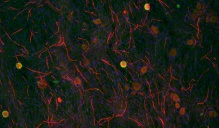
Fluorescence microscopy image of in vitro model of myelin sheath (red) formation by Schwann cells around neuronal axons (green). Cell nuclei are blue. Credit: Keit Men Wong, UB.
May 12, 2017
UB researchers studying myelination are discovering how metabolic diseases like diabetes may cause neuropathy.
BUFFALO, N.Y. — Diabetic neuropathy is one of the most common complications of diabetes. While not life-threatening, it affects millions in the U.S. and elsewhere, and leads to limb amputations if left unchecked. But the reasons why metabolic disease can lead to neuropathy, which is damage to the peripheral nervous system, have never been well-understood.
Now, in a paper published this week online in Proceedings of the National Academy of Sciences, researchers at the Hunter James Kelly Research Institute (HJKRI) at the University at Buffalo report on research that illuminates what causes some kinds of neuropathy and may reveal potentially powerful therapies.
PhD Student Development Program Gains Renewed Funding from NIH

Mohamed Sharif, a doctoral candidate in the HJKRI, Park Laboratory.
May 10, 2017
A National Institutes of Health (NIH) training grant aimed at providing professional development resources and mentoring for doctoral students in several UB schools has been renewed for another five years.
The Initiative for Maximizing Student Development (IMSD) will provide $2.3 million in funding to train 20 new biomedical and behavioral scientists from underrepresented groups between now and 2021.
The institutional grant benefits doctoral students in the following schools and institutes: Jacobs School of Medicine and Biomedical Sciences, School of Dental Medicine, School of Pharmacy and Pharmaceutical Sciences, School of Public Health and Health Professions, College of Arts and Sciences, School of Engineering and Applied Sciences and Roswell Park Cancer Institute Graduate Division.
[see sections entitled: "Flexibility Valuable Benefit of Program" & "Study Groups Encourage Interaction Between Students"...which quotes HJKRI Park Laboratory PhD Student, Mohamed Sharif]
Pathway Identified in Myelinating Glia Offers Hope for New Therapies

Doctoral student Keit Men Wong (left), Bogdan Beirowski, MD, PhD, and Elisabetta Babetto, PhD, are studying a pathway that plays a key role in regeneration of myelin sheaths.
May 9, 2017
Researchers at the Hunter James Kelly Research Institute (HJKRI) are highlighting the critical role of a metabolic checkpoint kinase pathway in Schwann cells for the formation of myelin sheaths.
“We are encouraged by our findings and think that our discoveries could be exploited to regenerate myelin sheaths and nerve structure to help patients with neurological disorders.”
This pathway, centered around the molecule “mammalian target of rapamycin (mTOR),” is known to play a paramount role in the regulation of cell metabolism, growth and cell division, as well as aging.
Nerve cells talk to each other by transmitting electrical signals along communication cables called axons, which are enwrapped by insulating myelin sheaths. The myelin sheaths produced by Schwann cells keep axons energized and healthy, and they facilitate the propagation of electrical signals by a process known as saltatory conduction.
Graduate Students Compete in First 3 Minute Thesis Event

Medical school graduate students, from left, Nadav Weinstock, Danielle Twum, Lucie Kafkova and Chong Zhang participated in UB’s first 3 Minute Thesis competition.
April 20, 2017
Four graduate students from the Jacobs School of Medicine and Biomedical Sciences were among the 15 finalists of UB’s inaugural 3 Minute Thesis (3MT) competition.
African Trypanosomes, Krabbe Disease Among Topics
Nadav Weinstock, a fifth-year MD/PhD student, aspires to become a physician-scientist working on developing therapies for rare diseases that affect babies.
During his first two years of medical school, Weinstock became interested in global health and spent time providing medical care at local free health clinics and to underserved remote populations in the Himalayan Mountains of India.
In 2016, he was awarded an F30 fellowship from the NIH for his research on Krabbe Disease.
His adviser in the Medical Scientist Training Program is M. Laura Feltri, MD, professor of biochemistry and neurology.
Weinstock’s presentation was titled “Understanding Krabbe Disease.”
Santiago-Gonzalez awarded an ASN Young Investigator Educational Enhancement Travel Award
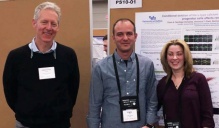
Lawrence Wrabetz, MD (left); Pablo M. Paez, PhD, and Diara Santiago-Gonzalez
March 19, 2017
Diara Santiago-Gonzalez, HJKRI graduate student in the Paez laboratory, was selected to receive a Young Investigator Educational Enhancement (YIEE) travel award to attend the American Society for Neurochemistry (ASN) meeting in Little Rock, Arkansas from March 18 to 22, 2017.
The YIEE award winners were recognized Sunday morning, March 19th before the sessions, at 8 am., according to Donna Osterhout, PhD, the Chair of the YIEE Selection Committee or the American Society for Neurochemistry.
Calcium Channel Research May Help Improve MS Therapies
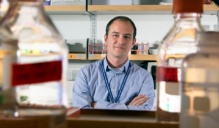
Pablo M. Paez, PhD
December 14, 2016
More researchers have identified a critical step in myelination after birth that has significance for treating neurodegenerative diseases like multiple sclerosis (MS).
In MS and similar diseases, myelin — the protective coating that neurons need to function — becomes lost or damaged.
New clues to myelination could help identify ways to intervene in neurodegenerative diseases
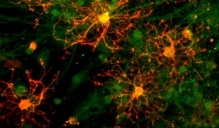
Cell culture containing oligodendrocytes with cortical neurons. Immature oligodendrocytes (bright yellow) interact with neurons (orange) during the first steps of the myelination process. (Credit: Pablo Paez)
December 7, 2016
UB researchers have identified a critical step in myelination after birth that has significance for treating neurodegenerative diseases like multiple sclerosis, in which myelin is lost or damaged. Myelin is the protective coating that neurons need to function.
The preclinical research, published online in October in the Journal of Neuroscience, concerns oligodendrocytes, the cells that make myelin, and the progenitor cells that are their precursors.
The work involved the study of voltage-operated calcium channels, which are responsible for initiating many physiological functions.
How myelin-making cells mature
“Our findings show that these calcium channels modulate the maturation of oligodendrocytes in the brain after birth,” said Pablo M. Paez, PhD, an assistant professor in the Department of Pharmacology and Toxicology in the Jacobs School of Medicine and Biomedical Sciences at UB and a research scientist with the Hunter James Kelly Research Institute (HJKRI) at UB, where most of the work was done.
“That’s important because it’s possible that the activity of this calcium channel can be manipulated pharmacologically to encourage oligodendrocyte maturation and remyelination after demyelinating episodes in the brain,” he said.
Three MD/PhD Students Receive NIH F30 Individual Fellowships

Nadav Weinstock
November 14, 2016
Three students in the Medical Scientist Training Program (MD/PhD) have received prestigious fellowships from the National Institutes of Health (NIH).
The Ruth L. Kirschstein National Research Service Award Fellowship (F30) is intended to enhance research and clinical training of promising predoctoral students who are matriculated in a combined MD/PhD training program and plan to pursue careers as physician-scientists.
“The three F30 fellowships represent a significant achievement for the students as well as for our MD/PhD training,” says Suzanne G. Laychock, PhD, director of the Medical Scientist Training Program and senior associate dean for faculty affairs and facilities.
The awards:
Research Focused on Krabbe Leukodystrophy
Title: “Cell Specific Ablation of Galc and the Pathogenesis of Krabbe Disease”
Principal investigator: Nadav Weinstock
Length of project: Four years
Total funding: $153,772
Weinstock is a fifth-year student who works in the lab of M. Laura Feltri, MD, professor of biochemistry and neurology.
Through his work at the Hunter James Kelly Research Institute (HJKRI), Weinstock developed a shared project on Krabbe Leukodystrophy (KL) with Lawrence Wrabetz, MD, HJKRI director and professor of neurology and biochemistry; and Daesung Shin, PhD, research assistant professor at HJKRI.
Weinstock aspires to become a physician-scientist in the field of pediatric neurology. His goal is to care for patients as a clinician while also conducting basic science research.
UB honors exceptional scholars, innovative teachers

M. Laura Feltri, MD
July 7, 2016
Fifteen of UB’s best and brightest teachers and researchers have been named recipients of the university’s 2016 Exceptional Scholar and Teaching Innovation awards.
All will be honored at the annual Celebration of Faculty/Staff Excellence, to be held on Oct. 20.
Research Shows Role of Mechanical Signaling in Myelination

M. Laura Feltri, MD
July 6, 2016
UB researchers led by M. Laura Feltri, MD, professor of biochemistry and neurology, have discovered that mechanical forces play a critical role in the formation of myelin. Their findings, published online June 6 in Nature Neuroscience, may signal a path to new therapies for multiple sclerosis and other myelin-related diseases.
Higgins announces $239,250 federal grant to UB for work at Hunter James Kelly Research Institute

Thomas Langan, MD
June 10, 2016
Grant aimed at early, accurate diagnosis of Krabbe disease, and aiding in the treatment of newborns.
Congressman Brian Higgins announced the State University of New York at Buffalo was awarded a federal grant totaling $239,250 from the U.S. Department of Health and Human Services toward the goal of enhancing the accuracy of newborn screening for Krabbe disease.
Myelin cells feel the force, UB researchers find
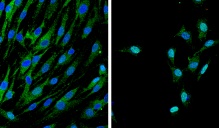
When two proteins required for myelination, Yap and Taz (green) are subjected to low mechanical stimulation, they stay in the cell cytoplasm (left) and don’t enter the nucleus (blue). But when subjected to higher mechanical stimulation, both proteins enter the nucleus, turning it blue-green, (right), triggering myelination. (Credit: Y. Poitelon, Feltri lab)
June 6, 2016
Mechanical forces play a critical role in myelination, the formation of the protective coating that neurons need to function, researchers at the University at Buffalo have discovered.
The UB researchers found that Schwann cells, the cells that form myelin in the nervous system, respond to mechanical stimuli by activating certain molecules that are then transferred to the nucleus to trigger myelination.
The finding opens new possibilities in developing treatments for myelin-related diseases.
Physician Scientists Association Grants Local Chapter to UB
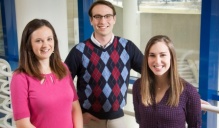
Chelsey Reed, medical school liaison (left); Nadav Weinstock, treasurer; and Lauren Burkard-Mandel, president; are among the student leaders of UB’s local APSA chapter.
March 11, 2016
The University at Buffalo’s Medical Scientist Training Program (MD/PhD) has been named a local chapter of the American Physician Scientists Association (APSA).
APSA is a national organization dedicated to addressing the needs of future physician-scientists with respect to their training and career development
Park Receives $1.8M Grant to Study Transcription Factor in Myelination

With funding from the National Institute of Neurological Disorders and Stroke, Yungki Park is researching the fundamental mechanism of myelin regulatory factor.
October 20, 2015
Yungki Park, PhD, assistant professor of biochemistry, has received a five-year, $1.8 million grant from the National Institute of Neurological Disorders and Stroke to study a transcription factor key to developing and maintaining myelin in the central nervous system.
New Research Technique Boosts Understanding of Myelin Diseases
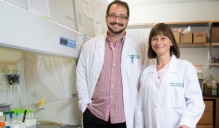
Research by Yannick Poitelon, PhD (left), and M. Laura Feltri, MD, boosts understanding of myelin diseases such as multiple sclerosis.
October 6, 2015
Researchers at the Hunter James Kelly Research Institute (HJKRI) have discovered a new way to study the interface where cells in the myelination process connect — a method that may lead to a better understanding of myelin diseases.
New candidate drug 'dials down' protein synthesis to treat demyelinating diseases

Lawrence Wrabetz, MD
April 21, 2015
UB researcher contributes to study on new candidate drug that may help treat misfolded protein diseases like CMT, Alzheimer’s and Parkinson’s.
“Motor function in the animals returned to normal, the amount of myelin destruction was reduced by 70 percent and myelin thickness improved remarkably” ...
Biochemist IDs Pathway Central to Stability of Nerve Axons

Bogdan K. Beirowski, MD, PhD
December 15, 2014
A University at Buffalo biochemist led the first study to identify the liver kinase B1 (LKB1) pathway as a possible therapeutic target for neuropathies, including diabetic neuropathy.

Steven J. Fliesler, PhD (left) and Lawrence Wrabetz, MD
Vision, Neurology Experts Named UB Distinguished Professors
July 15, 2014
Steven J. Fliesler, PhD, Meyer H. Riwchun Endowed Chair Professor of ophthalmology and professor of biochemistry, and Lawrence Wrabetz, MD, professor of neurology and biochemistry, have been named University at Buffalo Distinguished Professors, effective Sept. 1.
They are among five UB professors receiving this honor in 2014 in recognition of their scholarly distinction and leadership.
5 Departments Welcome New Faculty
February 21, 2014
Department of Biochemistry--Yungki Park, PhD, is an assistant professor. Park's research aims to increase knowledge about how oligodendrocyte differentiation is regulated for central nervous system myelination. His work could provide a firm basis for developing more effective therapeutics for demyelinating diseases.

Lawrence Wrabetz, MD, director of UB’s Hunter James Kelly Research Institute
UB Chosen to Co-Lead Major State Effort to Spur Genome Research
January 9, 2014
Gov. Andrew M. Cuomo has announced that the University at Buffalo will co-lead a statewide effort to position New York State as a national leader in genomic medicine.
At his State of the State address, Cuomo said UB will partner with the New York Genome Center (NYGC) in Manhattan to accelerate recent advances in genomic medicine directly into clinical care.
As part of this effort, UB will receive $50 million to increase research capacities.
UB will provide NYGC - a consortium of 16 educational and research organizations - with expertise and supercomputing power.
UB Study Seeks Molecular Mechanism Leading to Myelination
August 14, 2013
Pablo M. Paez, PhD, assistant professor of pharmacology and toxicology, will use a $1.74 million grant to study how cellular processes involving calcium channels contribute to myelination and myelin pathology.
Myelination Researcher Honored as Distinguished Postdoc Mentor
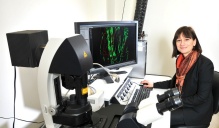
M. Laura Feltri, MD
July 30, 2013
M. Laura Feltri, MD, professor of biochemistry, has been honored with the 2013 Distinguished Postdoc Mentor Award. "I learned that the best strategy for me is to have a personalized approach. I give close to complete freedom to the best post-docs; others need more nurturing, especially at the beginning."
Sponsored by the University at Buffalo's Graduate School Office of Postdoctoral Scholars, the award was presented June 13 during the Postdoctoral Research Symposium.
"I am extremely honored by the award." says Feltri. "I feel it has true meaning because the nomination comes directly from my fellow co-workers.
Researchers ID Neuropathy Cause, Restore Myelination

Lawrence Wrabetz, MD
May 22, 2013
Neuroscientists at the University at Buffalo's Hunter James Kelly Research Institute (HJKRI) and European colleagues have provided proof of principle for how a genetic mutation leads to some neuropathies.
The international team also used a research drug to successfully alleviate the protein synthesis misstep, thereby improving myelin. Myelin is the fatty material that wraps the axons of neurons and allows them to signal effectively.
As a result, a potential new treatment strategy may be on the horizon for patients with a host of neurological disorders that result from misfolded proteins.

New Research Suggests Treatment for Neurological Disorders such as CMT, Alzheimer's
April 29, 2013
A potential new treatment strategy for patients with Charcot-Marie-Tooth disease is on the horizon, thanks to research by neuroscientists now at the University at Buffalo's Hunter James Kelly Research Institute and their colleagues in Italy and England.
The institute is the research arm of the Hunter's Hope Foundation, established in 1997 by Jim Kelly, Buffalo Bills Hall of Fame quarterback, and his wife, Jill, after their infant son Hunter was diagnosed with Krabbe Leukodystrophy, an inherited fatal disorder of the nervous system. Hunter died in 2005 at the age of eight. The institute conducts research on myelin and its related diseases with the goal of developing new ways of understanding and treating conditions such as Krabbe disease and other leukodystrophies.
Charcot-Marie-Tooth or CMT disease, which affects the peripheral nerves, is among the most common of hereditary neurological disorders; it is a disease of myelin and it results from misfolded proteins in cells that produce myelin.

Gustavo Della Flora Nunes
CURCA Funds Student's Biochemistry Research
February 28, 2013
An exchange student investigating the metabolic exchange that occurs between myelin and axons has received an award from the Center for Undergraduate Research and Creative Activities (CURCA).
Gustavo Della Flora Nunes, a scholar with Brazil's Science Without Borders program, conducts research with M. Laura Feltri, MD, professor of biochemistry and neurology.
Shedding Light on Axonal Damage Nunes' research could help scientists design protection for axons in demyelinating disorders like multiple sclerosis. He is studying what happens to axons when the metabolism of its surrounding glial cells is damaged. His research involves eliminating a crucial energy-producing component in myelinating glia. Myelin, made by glial cells, is the fatty sheath surrounding an axon, the part of a neuron that transmits impulses away from the cell body. Scientists believe that myelin cells provide nutrients and energy to neurons.

Sophie Belin, PhD
Postdoctoral Biochemist Awarded $40,000 Neuropathy Fellowship
September 5 , 2012
Sophie Belin, PhD, a postdoctoral research scientist in biochemistry, has received the 2012 Peripheral Nerve Society(PNS) Neuropathy Fellowship.
She was selected for the competitive $40,000 grant to investigate a pharmacological approach to treat hereditary neuropathy of the Charcot-Marie-Tooth (CMT) disease type.
Studying Arthritis Drug in Mouse Model of CMT Belin will work on the project with her mentor, Lawrence Wrabetz, MD, professor of neurology and biochemistry and director of the Hunter James Kelly Research Institute.
Arrival of Wrabetz and Feltri Moves Work of Kelly Institute Forward

Lawrence Wrabetz, MD and Laura Feltri, MD
November 3, 2011
The mission of the Hunter James Kelly Research Institute (HJKRI) is moving forward with great fervor with the recent arrival of highly regarded neuroscientists Lawrence Wrabetz and Laura Feltri.
Dubbed "physiccian-scientist superstars" by Michael Cain, dean of the School of Medicine and Biomedical Sciences, at the press conference in 2010 announcing the pair's recruitment to UB, Wrabetz is the institute's first director and holds a primary appointment in the Department of Neurology, with a secondary appointment in the Department of Biochemistry; Feltri has a primary appointment in Biochemistry.
The husband-wife research team arrived in Buffalo in late spring from Milan, Italy, with family and laboratories, including 10 research associates-eight of Italian and two of French descents-and 56 lines of transgenic mice.
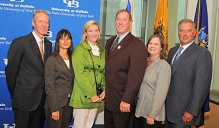
Attending a press conference to announce the appointments of Lawrence Wrabetz and Laura Feltri were, from left, Wrabetz, Feltri, Jill Kelly, Jim Kelly, Patricia Duffner and Michael Cain
Noted Researchers Join Kelly Institute
August 12, 2010
Lawrence Wrabetz, head of the myelin biology unit at San Raffaele Scientific Institute in Milan, Italy, has been appointed director of the Hunter James Kelly Research Institute (HJKRI) at UB.
Laura Feltri, who heads the neuroglia unit at the Italian institute and is Wrabetz's spouse, also has been recruited to the HJKRI, which was established in 2004 by UB and the Hunter's Hope Foundation. Wrabetz and Feltri will begin transitioning their laboratories to Buffalo this fall.
Both are highly regarded neuroscientists with significant backgrounds in basic and translational research on myelin, known as white matter-the sheath protecting brain nerve fibers that is essential for all normal functioning of the nervous system. They will work as a team in the HJKRI, located in UB's New York State Center of Excellence in Bioinformatics and Life Sciences on the Buffalo Niagara Medical Campus in downtown Buffalo.




